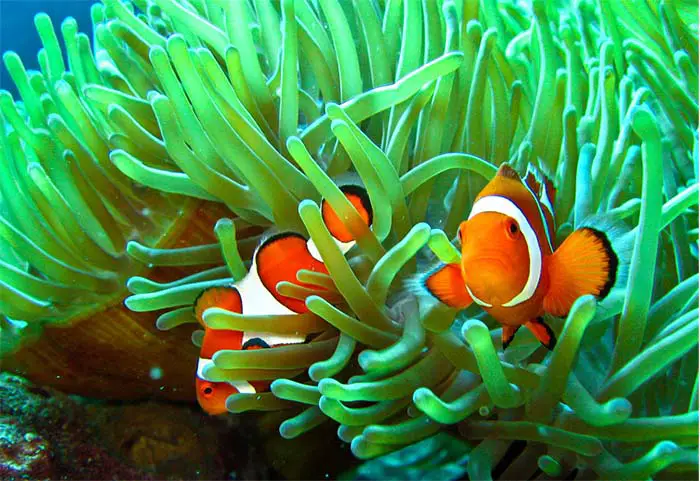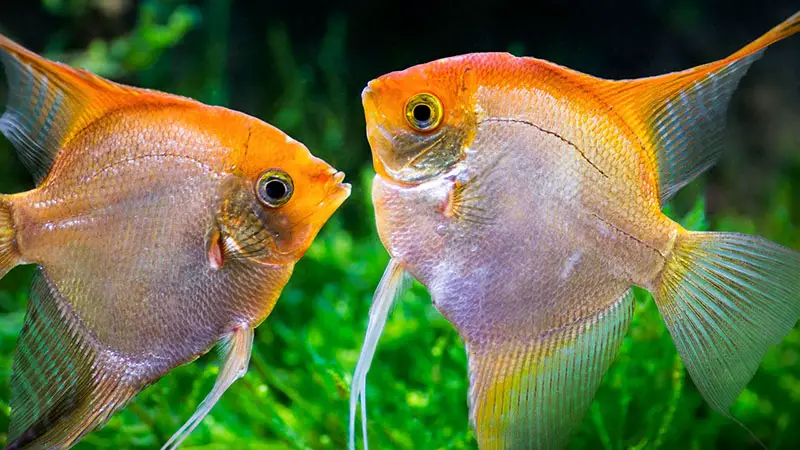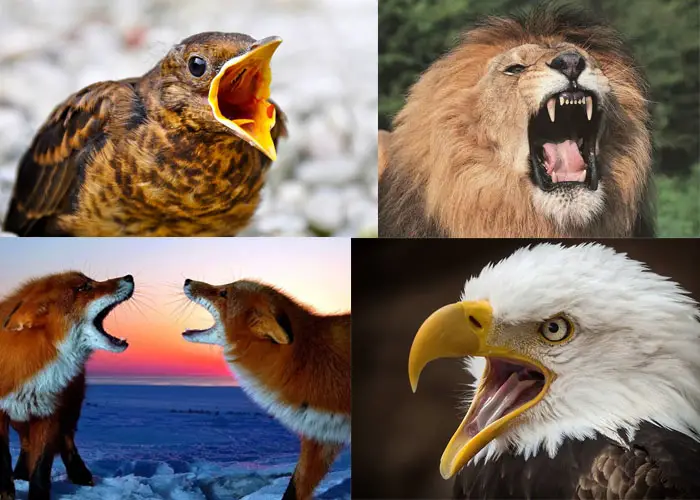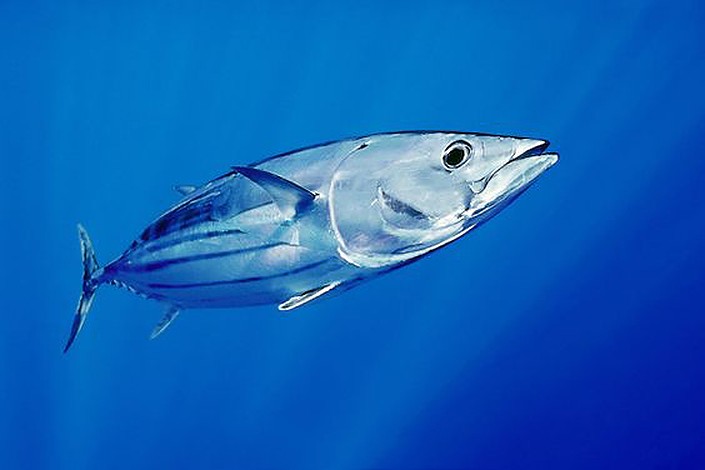Sea anemones are fascinating predatory creatures named after the terrestrial flowering plant known as anemone. They come in a variety of colours from red, yellow to bright blue! Sea anemones fall under the order Actiniaria. They are categorized under the phylum Cnidaria, and therefore they can be said as the cousins of sea creatures like corals, jellyfish and Hydra! But the life cycle differs slightly from that of the said cousins, for example, the medusa stage seen in the jellyfish is not be seen in the sea anemones. The class of sea anemone is Anthozoa while the subclass is Hexacorallia.
Morphology of Sea Anemone
A sea anemone’s structure is quite difficult to understand at a single glance but when you look thoroughly it won’t be much of a problem. It is a sessile polyp and the pedal disc attaches it column-shaped body to the surface. The column-shaped body can be cylindrical or not be cylindrical depending on the type of sea anemone. The surface of the body can be smooth or rough and may contain papillae.
At the top of the column-shaped body, you can see a structure called the oral disc. The oral disc is cannot seen in some species. They have a constricted version of it known as the capitulum. Sometimes the pedal disc is also absent and a bulbous structure which is called the physa attaches the body of the sea anemone to the surface.
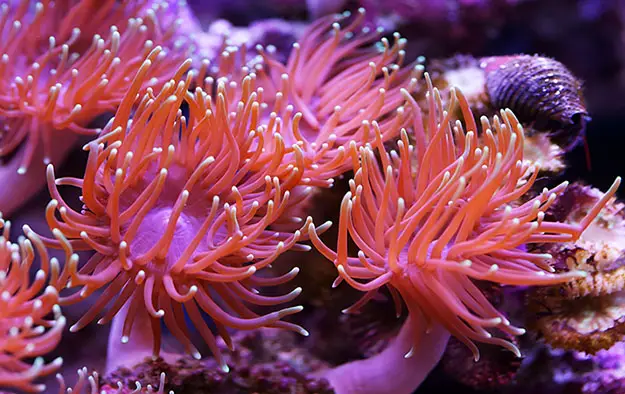
The oral disc is where the mouth is centrally located. It is a slit-shaped mouth having tentacles around it. The type of the tentacles depends on the type of sea anemone and in most of them the tentacles are branched.
Tentacles use as a defensive structure and to capture the prey. The tentacles have structures known as cnidocytes, in which there are nematocytes to inject the venom to paralyze the prey. This venom is a mixture of actinotoxins and neurotoxins but the actinotoxins are not harmful to clownfish and they have a mutual relationship with the sea anemone. There are some other defensive structures known as acrorhagi (just like tentacles) which has curled into a body of another sea anemone to fight it.
Although the morphology of all sea anemones is almost the same, the size varies; some may have a length of 1.5-10 centimetres and a diameter of 1-5 centimetres. But some of the sea anemones, believe it or not, goes up to a meter in length and diameter.
Behavior
A sea anemone can change their shape as they want because of the structure of the column shaped body and the tentacles. The transverse, longitudinal and the diagonal muscles of the column-shaped body can contract, relax, bend or curl.
As mentioned earlier, most of the sea anemone species are sessile polyps meaning that they attach to a surface by the pedal disc. They can able to move but the movement is very slow and cannot be seen with the naked eye. However, if you are fortunate enough you can detect the movement through a time-lapse camera. Sea anemones like to be at the same place for weeks or even months.
Some sea anemones can swim and walk at the same time. For example, Gonactinia prolifera walks just like how a caterpillar walks; by making short steps by its tentacles attaching into the surface in front of it and taking the base a little close to the tentacles in every movement. Swimming is done by using only the tentacles by beating each tentacle simultaneously to move forward.

Reproduction
Both asexual and sexual reproduction occurs in sea anemones.
Sea anemones reproduce asexually by regeneration, fragmentation, binary fission, budding and in some cases by pedal laceration. In this process, a part of the pedal disc of the parent sea anemone breaks off and regenerates into new sea anemones.
Male sea anemones release sperm and female sea anemones release eggs in sexual reproduction. The fertilization occurs outside the body or inside the gastrovascular cavity. The fertilized egg is then developed into planula larva and later to a juvenile sea anemone. Some sea anemones start as females in the early stages of their life cycle and are later turned into hermaphroditic sea anemones, meaning that they are having both female and male reproductive organs. So, in this case, female sea anemones can produce female offspring without fertilization and hermaphrodite sea anemones can undergo self-fertilization without the assistance of another sea anemone.
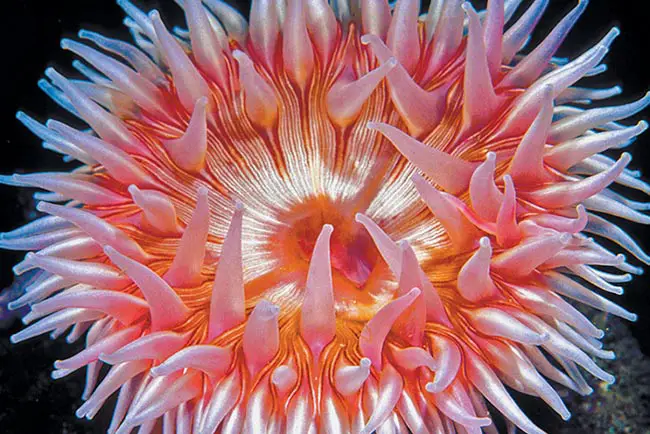
Habitats
Sea anemones are found in marine waters worldwide. Most of them are found in the tropical waters close to the equator and a few are adapted to cold environments. Sea anemones like to live attached to rocks or logs immersed in ocean water. Some prefer to live among the seaweed and some species burrow to the soft sediment or mud to make a home to themselves.
Diet of Sea Anemone
They are actually heterotrophs since they can’t produce own foods. Sea anemones use their tentacles to inject venom into their prey. Then prey paralyze and the sea anemone takes the prey into its mouth. They like to feed on small fish, small crustaceans, mussels, zooplankton, sea urchins and worms.

Mutualistic relationships
Sea anemones are creatures forming mutual relationships with other animals. The most well-known mutual relationship is between the sea anemone and the clownfish. This is a Symbiosis type relationship. The sea anemone gets the required nutrients from the faeces of the clownfish and in return protection from other predatory sea creatures is offered to the clownfish. Another instance is with the hermit crab. As the sea anemones can move slowly, it attaches to a hermit crab or lives in the shell. After that, it gains access to different types of food and environments. This relationship is beneficial only to the sea anemone.
Sea anemones and algae also form a mutual relationship. The algae live in the tentacles or the oral disc of the sea anemone and are protected from the herbivores. Constant sunlight is gained to do photosynthesis. In return, the algae provide the sea anemone with required nutrients; oxygen, glucose, glycerol and alanine obtained through photosynthesis.

